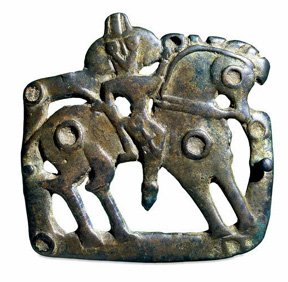
Parthian, 2nd-3rd century AD
Leaded bronze
Height: 7 cm
Width: 7.2 cm
Acquisition number: #ANE 139205
Image courtesy of the British Museum (copyright reserved)
This belt buckle depicts a helmeted Parthian horseman armed with bearing a large ring in his left hand, while his right hand rests on the back of his saddle. Like the rider, the horse is highly stylized. Studies of Parthian statuary indicate that such flamboyant belt buckles were common during this times, particularly those found on the statues recovered from the contemporary caravan city of Hatra on the western edge of the Parthian Empire, in northern Mesopotamia.1
Not much remains of any Hellenistic influence in this piece, yet neither do we see strong reference to the pre-Seleucid Achaemenid culture, which so interested the Parthians in the later centuries. Rather, this belt buckle speaks to us of the nomadic culture of peoples who settled in the northern parts of Parthia. These peoples settled in the lands east of the Caspian Sea, and contributed much to Parthian culture as they were integrated into a more sedentary lifestyle.
(1) See the British Museum web page dedicated to this object.